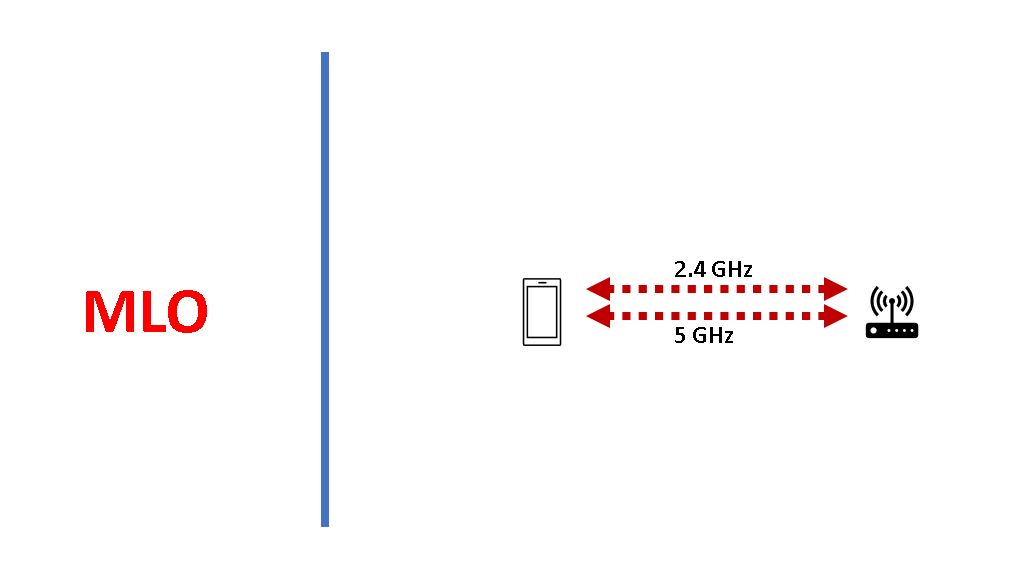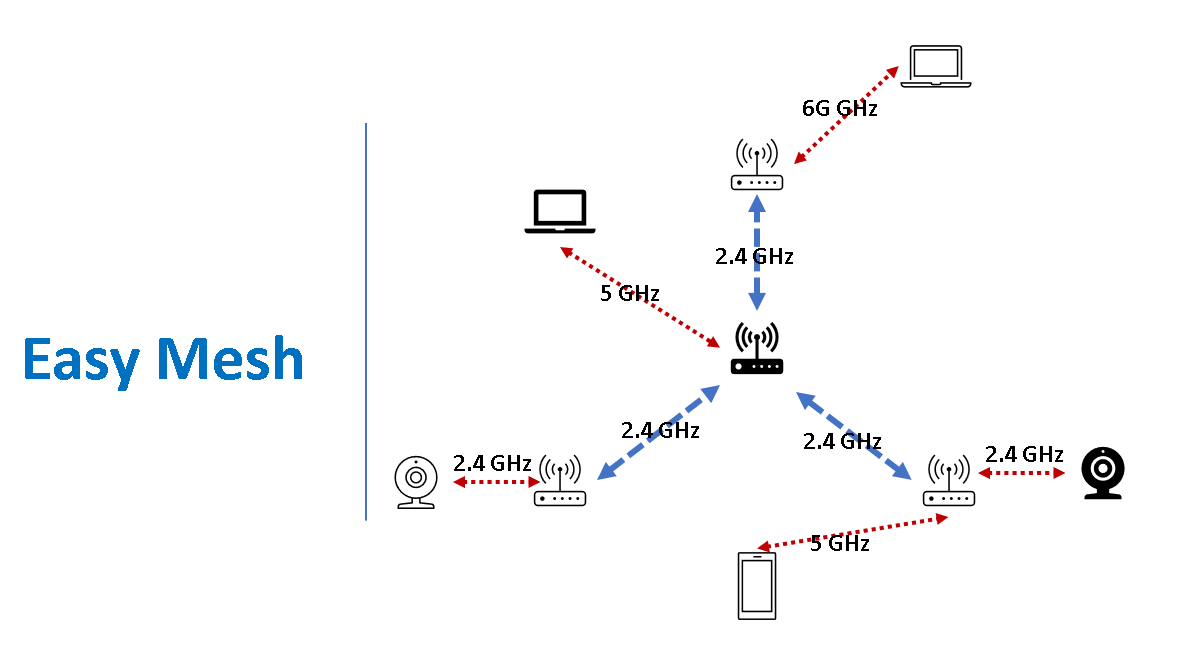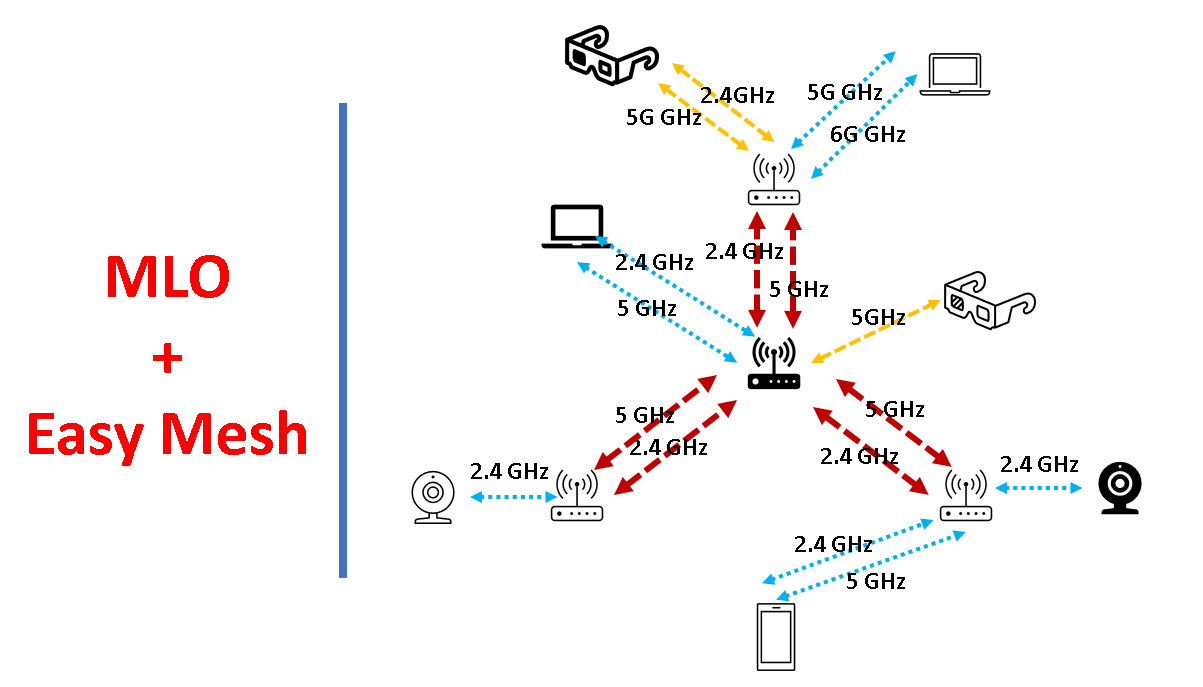Child Pages
Contents
Introduction:
Explore the innovation of WI-FI 7, MLO, and EasyMesh technology. Qualcomm WI-FI 7 enhances EasyMesh’s wireless speed through MLO technology, reduces network latency, provides users with an ultra-fast and stable wireless experience, and easily manages the entire network environment.
What are MLO and Easy Mesh
MLO (Multi-Link Operation)
MLO is a WI-FI 7 technology that allows devices to use multiple wireless connection channels simultaneously, improving overall transmission capabilities. Through MLO, WI-FI devices can more effectively utilize multiple connections to achieve faster and more stable wireless network connections. This helps improve the performance of wireless devices, especially in high-density environments.
WI-FI7 MLO Diagram

EasyMesh
EasyMesh is a standard established by the WI-FI Alliance aimed at simplifying and enhancing the deployment and management of WI-FI Mesh networks. WI-FI Mesh technology allows multiple devices (nodes) to work together, forming a seamless network that provides broader coverage and more stable connections. EasyMesh’s goal is to ensure that Mesh devices from different vendors can interoperate, allowing users to more easily expand and manage the entire network.
EasyMesh Diagram

MLO and EasyMesh Integration
Integrating MLO technology with EasyMesh can provide users with a more efficient, stable, and faster wireless network experience. MLO improves connection speed and performance, while EasyMesh simplifies the configuration and management of the entire Mesh network. The combination of both allows users to more easily have a powerful and easily expandable wireless network.
WI-FI7 MLO + EasyMesh Diagram

Pros and Cons of MLO with EasyMesh
Advantages of MLO with EasyMesh
-
Enhanced Wireless Speed: MLO technology can use multiple connections simultaneously, improving EasyMesh’s wireless networking speed and ensuring higher transmission efficiency.
-
Reduced Network Latency: MLO technology’s real-time dynamic adjustment of connection configurations helps reduce network latency, providing faster data transmission and instant response.
-
Seamless Roaming Experience: The combination of MLO and EasyMesh makes seamless roaming between different nodes possible, allowing users to maintain stable connections while moving.
-
Adaptation to High-Density Environments: Using MLO and EasyMesh together helps address the needs of high-density device connections, suitable for crowded venues such as conference rooms or event spaces.
-
Simple Network Management: Network environments integrating MLO and EasyMesh are easier to manage, with automatic configuration optimization, eliminating the need for users to perform complex manual settings.
Disadvantages of MLO with EasyMesh
-
Higher Hardware Requirements: Implementing MLO and EasyMesh functionality may require relatively high-performance hardware, which could increase costs.
-
More Complex Configuration: Integrating two technologies requires more complex configuration, which may require additional learning costs for general users.
-
Standard Compatibility: Some older or different brand devices may not fully support MLO and EasyMesh, leading to standard compatibility issues.
-
Learning Curve: For new technology combinations, users and administrators may need some time to adapt to new features and operation methods.
-
May Require Longer Transition Period: Older devices do not support this integrated new technology, so during the transition period, users may not be able to fully experience all new features.
Conclusion
The combination of MLO and EasyMesh brings a series of exciting advantages in the wireless network field. Through MLO’s multi-connection operations, wireless connection speed and stability are improved, while EasyMesh provides simple management and seamless roaming features, making the overall experience more outstanding. This integration creates an ultra-fast, stable, and easily manageable wireless network environment that meets the needs of modern high-performance wireless applications. Users can enjoy faster connections, seamless switching, and more flexible network management. This combination indeed represents a major leap forward in wireless network technology.
Q&A
WI-FI 7:
Question: What is WI-FI 7? How does it differ from existing WI-FI technologies?
Answer: WI-FI 7 is the next-generation WI-FI standard that brings higher transmission speeds, lower latency, and better performance. Compared to existing WI-FI 6/6E, WI-FI 7 supports more simultaneous device connections and provides more powerful network performance.
MLO (Multi-Link Operation)
Question: How does MLO improve WI-FI connection performance?
Answer: MLO allows devices to use multiple wireless connection channels simultaneously, which improves overall transmission capabilities, enhances connection performance and stability, and reduces network latency.
EasyMesh
Question: What is EasyMesh? How does it improve home WI-FI networks?
Answer: EasyMesh is a WI-FI Mesh standard that allows multiple routers or access points to work together, providing broader coverage, seamless roaming, and simple network management, improving the reliability and flexibility of home WI-FI.
Integrating WI-FI 7, MLO, and Easy Mesh
Question: Why integrate WI-FI 7, MLO, and Easy Mesh? What are the advantages?
Answer: Integrating these three can bring faster, more stable, and more flexible wireless connection experiences. WI-FI 7 provides the latest technology standards, MLO improves performance, and Easy Mesh provides broad coverage and seamless roaming.
User Experience
Question: What practical significance does integrating WI-FI 7, MLO, and Easy Mesh have for general users?
Answer: This means faster network speeds, more reliable connections, and maintaining connectivity wherever you are. Users can enjoy seamless high-speed connection experiences while being able to simply manage the entire network environment, improving the convenience and efficiency of wireless communications.
